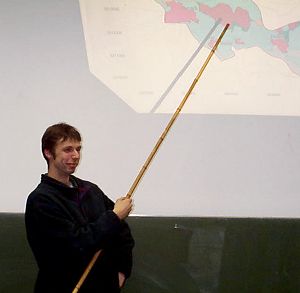
Abstract
![]()

![]()
A groundwater model for an aquifer near Ostrach was developed in cooperation with the Büro für Hydrogeologie Funk (Bollschweil, near Freiburg). The Finite Difference Method was used as the basis for the model, and the Modflow code (McDonald & Harbaugh, 1988; slightly changed to Visual Modflow) was used to perform the modelling calculations.
The study area is situated near Ostrach, 30 km southeast of Sigmaringen. The size of the area is about 15 sq. km. The geology of the area is dominated by Molasse and by Quarternary deposits. Outwash terraces produced during the Mindel glaciation appear to be the oldest Quarternary deposits. The aquifer is formed by glacial outwash of Würm age deposited in valleys produced during the Riss glaciation. The recharge area for the aquifer is bounded to the east by the Rhine/Danube watershed.
The study area has an irregular outline, and so it was modelled using a larger, rectangular modelling area of 160 by 100 cells; each cell was 50 by 50 m in size.
The depth of the aquifer base at the centres of the cells was interpolated from measurements made in 110 observation and pumping wells, 60 other boreholes, and from geo-electrical and seismic data.
Pumping tests in the wells were used to create a regionalized distribution of the hydraulic conductivity; the values of hydraulic conductivity varied between 10e-3 m/s in the western part of the area and about 10e-8 m/s in the eastern parts.
The Haude-Renger Method was used to calculate the groundwater recharge in different parts of the area. It was therefore necessary to interpret the soil map of Ostrach, a simplified land-use map, and climatological data.
These various hydrogeological data were used as input to Visual Modflow, and a first result for the hydraulic head distribution was obtained. The calculated head for a steady-state model was compared with the head distribution measured in 1994.
The calculated head distribution was too high, especially in the eastern part of the area. Flow directions could be simulated quite well, however.
The model still remains to be calibrated. This will involve adjusting parameters other than basic input data. Hydraulic conductivity is the most important parameter controlling the flow. After calibration, the model can be expected to give approximate hydraulic conductivities for regions which have no measured transmissivity values.
![]()
Diplomanden-Doktoranden Seminar WS 97/98 Zur Homepage des Geologischen Institut